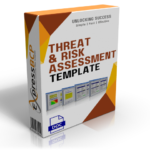Here’s a shocking fact: 40% of businesses never recover after a major disaster, and another 25% shut their doors within a year. That’s right, nearly two-thirds of companies fail to bounce back from a significant disruption. But here’s the good news—your business doesn’t have to be one of them! By including the key components of an effective Business Continuity Plan (BCP) and having a solid plan in place, you can significantly increase your chances of survival and quickly resume business operations.
A well-crafted BCP isn’t just a “nice-to-have.” It’s a lifeline. And here, we’ll break down the key components that make it effective—no fluff, just the essentials to keep your operations resilient. Let’s dive in!
1. Risk Assessment and Business Impact Analysis
The first step to building an effective BCP is to understand the risks your business faces. What could go wrong? Natural disasters, cyberattacks, supply chain disruptions—every business is vulnerable to something. Conduct a thorough Risk Assessment to find these potential threats, but don’t stop there.
Follow this with a Business Impact Analysis (BIA) to figure out what happens if those risks become reality. What’s the fallout if a key system crashes? How long can you survive without your critical processes running? The BIA helps you rank your business functions in terms of importance. It pinpoints the weak links in your operations, so you know exactly where to focus your recovery efforts.
Tip: It’s crucial to be specific. Don’t generalize your risks; name them and give them a rating.
Download our Business Continuity Plan Template to simplify this process and get detailed examples of risk assessment and impact analysis.
2. Business Continuity Strategies
Now that you’ve identified the risks, how will you respond? This is where business continuity strategies come into play. What’s your game plan if your main office floods? How do you keep your teams productive during a network outage?
You need practical, realistic strategies to keep essential functions going. These can range from enabling employees to work from home to arranging backup suppliers or moving critical systems to the cloud.
Each strategy should focus on the “what ifs” specific to your business. The goal? Guarantee minimal disruption and keep the wheels turning, no matter what comes your way.
Tip: Think scalability. Your strategies should grow with your business and adapt to different levels of disruption.
3. Clear Roles and Responsibilities
An effective BCP needs a clear chain of command. Who’s in charge if disaster strikes? Who ensures communication flows smoothly between departments? Who coordinates with external partners or emergency services?
Assign roles and responsibilities in your plan to avoid confusion when every second counts. This is one area where many businesses stumble—without knowing who’s responsible for what, delays and mistakes pile up quickly. Define these roles ahead of time, and make sure everyone knows their part.
Actionable tip: Hold regular training sessions to keep your team sharp. Practice makes perfect, especially in high-pressure situations.
4. Communication Plan
It’s impossible to overstate the importance of communication during a crisis. Employees, customers, suppliers, and stakeholders need to know what’s happening, fast. That’s why a solid communication plan is a must.
Your plan should outline who to contact, when to contact them, and how. Whether you’re sending out updates via email, social media, or phone, the goal is clear, consistent messaging. Having a backup communication method is just as important—what if the internet’s down or phone lines are cut?
Tip: Pre-draft some communication templates for different scenarios, so you’re not scrambling in the heat of the moment.
5. Data Backup and Recovery
Data is the lifeblood of modern businesses and losing it is catastrophic. A crucial part of any BCP is a data backup and recovery plan. Where will you store backups? How often will they be updated? And most importantly, how will you restore that data if disaster strikes?
Cloud solutions, immutable backups, or even offsite storage facilities—there are multiple options to safeguard your data. But having a backup isn’t enough. You need a detailed recovery process that lets you get up and running with minimal downtime.
Tip: Regularly test your backup and recovery procedures. Don’t assume it’ll work smoothly when you need it most!
6. Testing and Continuous Improvement
A BCP isn’t something you create and then forget about. Your plan should be a living document. Regular testing and drills will expose gaps and areas for improvement. Run simulations that mimic real-life disruptions, then tweak your plan based on the results.
After every test, ask yourself: What went well? What needs fixing? Were there any surprises? This process of continuous improvement will make your BCP more robust over time. Businesses evolve, so should your continuity plan.
Tip: At least, schedule annual reviews. Update your plan whenever there’s a significant change in your business, like new technology, partnerships, or a major expansion.
Why wait? Stay Ready with the Right Tools
At the end of the day, an effective business continuity plan is your company’s best insurance policy. It protects your operations, your people, and your reputation. But crafting one from scratch can be overwhelming, and that’s where our BCP templates come in.
They’re designed to help you develop a tailored plan in no time—whether you’re a small business or a seasoned professional looking to refine your strategy. Don’t wait for disaster to strike before getting prepared. Download your Business Continuity Plan Template from ExpressBCP today and stay one step ahead!







